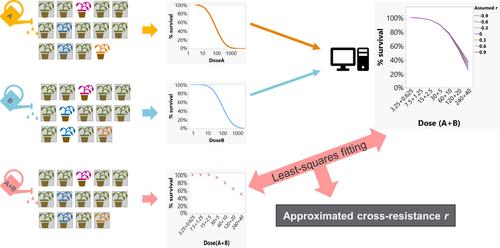当前位置:
X-MOL 学术
›
Pest Manag. Sci.
›
论文详情
Our official English website, www.x-mol.net, welcomes your
feedback! (Note: you will need to create a separate account there.)
Inferring herbicide non‐target‐site cross‐resistance from dose response and mixture treatments
Pest Management Science ( IF 3.8 ) Pub Date : 2025-01-20 , DOI: 10.1002/ps.8658
Chun Liu, Stephen R. Moss, Anastasia Perraki, Will Plumb, Shiv S. Kaundun
Pest Management Science ( IF 3.8 ) Pub Date : 2025-01-20 , DOI: 10.1002/ps.8658
Chun Liu, Stephen R. Moss, Anastasia Perraki, Will Plumb, Shiv S. Kaundun

|
BACKGROUNDHerbicide cross‐resistance is of increasing concern because it compromises the effectiveness of both existing and new chemical options. However, a common misconception is that if a weed population shows dose–response shifts to two herbicides, it is cross‐resistant to both. The possibility that individual plants may possess different resistance mechanisms is often overlooked.RESULTSTo better characterise non‐target‐site cross‐resistance, we propose that the accession be treated with mixtures of the two herbicides of interest. A population model could be used to simulate the expected dose responses to the mixtures, assuming different cross‐resistance levels in the population, as well as synergistic or antagonistic effects between the two herbicides. The simulated responses can then be compared with the actual responses, and the cross‐resistance level approximated. We demonstrated this approach from a mathematical standpoint and validated it with experimental data from glasshouse tests on four well‐characterised biotypes of Lolium multiflorum and two commercial herbicides, clodinafop and iodosulfuron. Results also showed that understanding chemical interactions such as synergy and antagonism is crucial to a better estimate of cross‐resistance levels.CONCLUSIONBecause this method utilises standard dose–response tests, it is potentially easier and less time‐consuming than those involving plant cloning or divergent recurrent selection. Quick characterisation of the degree of cross‐resistance provides important insights as to whether chemical rotations or mixtures can still effectively control the weed population displaying resistances to multiple herbicides. This approach could be applied more broadly in cross‐resistance studies with other xenobiotics. © 2025 Society of Chemical Industry.
中文翻译:

从剂量反应和混合处理推断除草剂非靶位点交叉抗性
背景杀虫剂交叉耐药性越来越受到关注,因为它损害了现有和新化学选择的有效性。然而,一个常见的误解是,如果杂草种群表现出对两种除草剂的剂量反应转变,那么它对这两种除草剂都有交叉抗性。单个植物可能具有不同抗性机制的可能性经常被忽视。结果为了更好地表征非靶位点交叉抗性,我们建议用两种感兴趣的除草剂的混合物处理种质。种群模型可用于模拟对混合物的预期剂量反应,假设种群中的交叉抗性水平不同,以及两种除草剂之间的协同或拮抗作用。然后可以将模拟响应与实际响应进行比较,并近似得出交叉阻力水平。我们从数学的角度证明了这种方法,并通过对四种明确表征的 Lolium multiflorum 生物型和两种商业除草剂氯地那福和碘磺隆的温室测试实验数据进行了验证。结果还表明,了解化学相互作用(如协同作用和拮抗作用)对于更好地估计交叉耐药水平至关重要。结论由于这种方法利用了标准的剂量反应测试,因此它可能比涉及植物克隆或发散性循环选择的方法更容易且耗时更少。交叉抗性程度的快速表征为化学轮换或混合物是否仍能有效控制对多种除草剂表现出抗性的杂草种群提供了重要见解。这种方法可以更广泛地应用于与其他外源性物质的交叉抗性研究。 © 2025 化工学会.
更新日期:2025-01-20
中文翻译:

从剂量反应和混合处理推断除草剂非靶位点交叉抗性
背景杀虫剂交叉耐药性越来越受到关注,因为它损害了现有和新化学选择的有效性。然而,一个常见的误解是,如果杂草种群表现出对两种除草剂的剂量反应转变,那么它对这两种除草剂都有交叉抗性。单个植物可能具有不同抗性机制的可能性经常被忽视。结果为了更好地表征非靶位点交叉抗性,我们建议用两种感兴趣的除草剂的混合物处理种质。种群模型可用于模拟对混合物的预期剂量反应,假设种群中的交叉抗性水平不同,以及两种除草剂之间的协同或拮抗作用。然后可以将模拟响应与实际响应进行比较,并近似得出交叉阻力水平。我们从数学的角度证明了这种方法,并通过对四种明确表征的 Lolium multiflorum 生物型和两种商业除草剂氯地那福和碘磺隆的温室测试实验数据进行了验证。结果还表明,了解化学相互作用(如协同作用和拮抗作用)对于更好地估计交叉耐药水平至关重要。结论由于这种方法利用了标准的剂量反应测试,因此它可能比涉及植物克隆或发散性循环选择的方法更容易且耗时更少。交叉抗性程度的快速表征为化学轮换或混合物是否仍能有效控制对多种除草剂表现出抗性的杂草种群提供了重要见解。这种方法可以更广泛地应用于与其他外源性物质的交叉抗性研究。 © 2025 化工学会.































 京公网安备 11010802027423号
京公网安备 11010802027423号